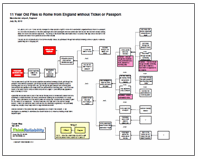By Kim Smiley
Many people have heard of the Hindenburg, but have you heard of the USS Akron? The Hindenburg crashed in 1937, killing 35 people. The USS Akron crash four years earlier killed 73, making it the deadliest airship crash in history.
The crash of the USS Akron can be investigated by building a Cause Map, a visual format for performing a root cause analysis. A Cause Map is built by asking “why” questions to determine what causes contributed to an issue. The causes are organized on the Cause Map to illustrate the cause-and-effect relationships between them. Why were 73 people killed? This occurred because they were onboard the USS Akron, the airship struck the ocean surface, the crew had little time to brace for impact and there were insufficient flotation devices onboard.
The crew was onboard the USS Akron because the airship was operated by the US Navy and was performing a routine mission at the time of the crash. The airship hit the ocean because it was operating over the ocean and lost altitude in a severe storm. Why was the airship operating in a storm? There was no severe weather predicted at the time and a low pressure system unexpectedly developed. The crew had little time to brace for the impact because they weren’t aware that an impact was imminent. There was low visibility at the time because it was a stormy, dark night. The barometric altimeter was also showing that the airship was higher than it actually was. Barometric altimeters are affected by pressure and the low pressure in the storm impacted more than the crew realized. The lack of life jackets and other floatation devices also contributed to the high number of deaths. There were no life jackets onboard the airship at the time of the crash and only one rubber raft. The safety equipment had been given to another airship and had never been replaced.
While few of us plan to operate or build an airship anytime in the near future, the important of keeping sufficient safety gear onboard any vehicle of any kind is an important lesson. Lack of safety gear is a reoccurring theme in many historical disasters. For example, the sinking of the Titanic would be a very different story if there had been sufficient lifeboats onboard. This example might be very different if the crew had been wearing life jackets. The airship would still have been lost, but there would likely have been fewer casualties.
To view a high level Cause Map of this example, click on “Download PDF” above.







